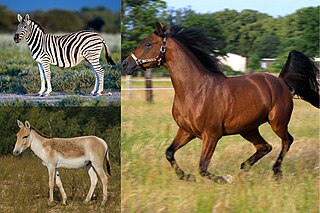 W
WEquus is a genus of mammals in the family Equidae, which includes horses, donkeys, and zebras. Within the Equidae, Equus is the only recognized extant genus, comprising seven living species. Like Equidae more broadly, Equus has numerous extinct species known only from fossils. The genus most likely originated in North America and spread quickly to the Old World. Equines are odd-toed ungulates with slender legs, long heads, relatively long necks, manes, and long tails. All species are herbivorous, and mostly grazers, with simpler digestive systems than ruminants but able to subsist on lower-quality vegetation.
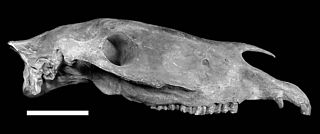 W
WAmerhippus is an extinct South American horse of uncertain taxonomic identity in the genus Equus. It is sometimes classified as a subgenus containing several extinct species of horses that lived in South America, or a single, morphologically variable extinct species Equus neogeus.
 W
WAsinus is a subgenus of Equus that encompasses several subspecies of the Equidae commonly known as wild asses, characterized by long ears, a lean, straight-backed build, lack of a true withers, a coarse mane and tail, and a reputation for considerable toughness and endurance.
 W
WGrévy's zebra, also known as the imperial zebra, is the largest living wild equid and the most threatened of the three species of zebra, the other two being the plains zebra and the mountain zebra. Named after Jules Grévy, it is found in Kenya and Ethiopia. Compared with other zebras, it is tall, has large ears, and its stripes are narrower.
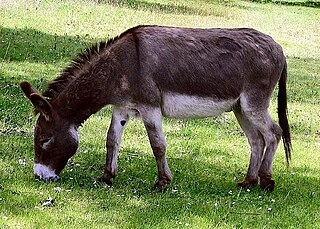 W
WThe donkey or ass is a domestic animal in the horse family. It derives from the African wild ass, Equus africanus, and has been used as a working animal for at least 5000 years. There are more than 40 million donkeys in the world, mostly in underdeveloped countries, where they are used principally as draught or pack animals. Working donkeys are often associated with those living at or below subsistence levels. Small numbers of donkeys are kept for breeding or as pets in developed countries.
 W
WGrévy's zebra, also known as the imperial zebra, is the largest living wild equid and the most threatened of the three species of zebra, the other two being the plains zebra and the mountain zebra. Named after Jules Grévy, it is found in Kenya and Ethiopia. Compared with other zebras, it is tall, has large ears, and its stripes are narrower.
 W
WEquus is a genus of mammals in the family Equidae, which includes horses, donkeys, and zebras. Within the Equidae, Equus is the only recognized extant genus, comprising seven living species. Like Equidae more broadly, Equus has numerous extinct species known only from fossils. The genus most likely originated in North America and spread quickly to the Old World. Equines are odd-toed ungulates with slender legs, long heads, relatively long necks, manes, and long tails. All species are herbivorous, and mostly grazers, with simpler digestive systems than ruminants but able to subsist on lower-quality vegetation.
 W
WHaringtonhippus is an extinct genus of stilt-legged equine from the Pleistocene of North America first described in 2017. The genus is monospecific, consisting of the species H. francisci, initially described in 1915 by Oliver Perry Hay as Equus francisci. Prior to its formal description, it was sometimes referred to as the New World stilt-legged horse.
 W
WHaringtonhippus is an extinct genus of stilt-legged equine from the Pleistocene of North America first described in 2017. The genus is monospecific, consisting of the species H. francisci, initially described in 1915 by Oliver Perry Hay as Equus francisci. Prior to its formal description, it was sometimes referred to as the New World stilt-legged horse.
 W
WEquus scotti is an extinct species of Equus, the genus that includes the horse.
 W
WThe horse is a domesticated one-toed hoofed mammal. It belongs to the taxonomic family Equidae and is one of two extant subspecies of Equus ferus. The horse evolved over the past 45 to 55 million years from Eohippus, a small multi-toed creature, into the large, single-toed animal of today. Humans began domesticating horses around 4000 BC, and their domestication is believed to have been widespread by 3000 BC. Specifically, horses in the subspecies caballus are domesticated, although some domesticated populations live in the wild as feral horses. However, these feral populations are not true wild horses, as this term is used to describe horses that have never been domesticated. There is an extensive, specialized vocabulary used to describe equine-related concepts, covering everything from anatomy to life stages, size, colors, markings, breeds, locomotion, and behavior.
 W
WHaringtonhippus is an extinct genus of stilt-legged equine from the Pleistocene of North America first described in 2017. The genus is monospecific, consisting of the species H. francisci, initially described in 1915 by Oliver Perry Hay as Equus francisci. Prior to its formal description, it was sometimes referred to as the New World stilt-legged horse.
 W
WEquus conversidens, or the Mexican horse, is a dubious Pleistocene species of horse, now extinct, that inhabited North America.
 W
WThe term tarpan refers to free-ranging horses of the Russian steppe from the 18th to the 20th century. It is generally unknown whether those horses represented genuine wild horses, feral domestic horses or hybrids .The last individual believed to be a tarpan died in captivity in the Russian Empire during 1909.
 W
WEquus lambei is an extinct species of the genus Equus. Equus lambei ranged across North America until approximately 10,000 years ago. Based on recent examinations of the mtDNA of Equus lambei remains, scientists have concluded that E. lambei was probably much like the extinct Tarpan, also known as the Eurasian wild horse, and the living Przewalski's Horse.[6][8] A partial carcass of Equus lambei is on display at the Yukon Beringia Interpretive Centre in Whitehorse, Yukon.
 W
WEquus namadicus is a prehistoric equid, known from equid remains dating to the Pleistocene excavated in deposits of the Narmada river, in India. It is contemporary and possibly even identical to, Equus sivalensis.
 W
WEquus occidentalis or the Western horse, was a Pleistocene species of horse, now extinct, that inhabited North America, specifically the southwest region of the United States.
 W
WHaringtonhippus is an extinct genus of stilt-legged equine from the Pleistocene of North America first described in 2017. The genus is monospecific, consisting of the species H. francisci, initially described in 1915 by Oliver Perry Hay as Equus francisci. Prior to its formal description, it was sometimes referred to as the New World stilt-legged horse.
 W
WEquus scotti is an extinct species of Equus, the genus that includes the horse.
 W
WEquus sivalensis is an extinct equid, discovered in the Siwalik hills. Remains date to 2.6 million years ago, and it is assumed that it was extinct during the last Ice Age, between 75,000 and 10,000 years ago, as part of the late Pleistocene megafaunal extinction. Remains have been found in middle to late Pleistocene locations in the Siwaliks and in Tamil Nadu, and recently, as a "Great Indian horse" in Andhra, dated to ca. 75,000 BP.
 W
WEquus stenonis or the Stenon zebra, was an extinct species of zebra that inhabited Eurasia in the Pleistocene.
 W
WHaringtonhippus is an extinct genus of stilt-legged equine from the Pleistocene of North America first described in 2017. The genus is monospecific, consisting of the species H. francisci, initially described in 1915 by Oliver Perry Hay as Equus francisci. Prior to its formal description, it was sometimes referred to as the New World stilt-legged horse.
 W
WHartmann's mountain zebra is a subspecies of the mountain zebra found in far south-western Angola and western Namibia.
 W
WThe Cape mountain zebra is a subspecies of mountain zebra that occurs in certain mountainous regions of the Western and Eastern Cape provinces of South Africa.
 W
WThe term tarpan refers to free-ranging horses of the Russian steppe from the 18th to the 20th century. It is generally unknown whether those horses represented genuine wild horses, feral domestic horses or hybrids .The last individual believed to be a tarpan died in captivity in the Russian Empire during 1909.
 W
WThe European wild ass or hydruntine is an extinct equine from the Middle Pleistocene to Late Holocene of Western Eurasia. It appeared first in the fossil record around 350-300,000 years before present. In the late Pleistocene it was widespread throughout much of western Eurasia from the Middle East to Europe, especially along the Mediterranean, with fossil reports from Sicily, Turkey, Spain, France and Portugal. In the east the range apparently stretched at least to the Volga and to Iran. In the north it reached almost to the North Sea in Germany and the British Isles. Its range fragmented after the Last Glacial Maximum, surviving into the Holocene, its range gradually contracted further, persisting in small regions of southern Europe into the Bronze age, and in Iran and the Caucasus into the Iron Age, around 500 BC. It has been suggested that the Iberian Zebro, extinct in the wild from the 16th century, could correspond to the Equus hydruntinus, although the word "zebro" or "cebro" comes from Latin equiferus meaning 'wild horse'. Later research judged that it was unlikely that hydruntines persisted in the Iberian Peninsula beyond the Chalcolithic.
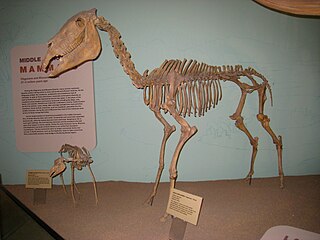 W
WThe Hagerman horse, also called the Hagerman zebra or the American zebra, was a North American species of equid from the Pliocene epoch and the Pleistocene epoch. It was one of the oldest horses of the genus Equus and was discovered in 1928 in Hagerman, Idaho. It is the state fossil of Idaho.
 W
WHaringtonhippus is an extinct genus of stilt-legged equine from the Pleistocene of North America first described in 2017. The genus is monospecific, consisting of the species H. francisci, initially described in 1915 by Oliver Perry Hay as Equus francisci. Prior to its formal description, it was sometimes referred to as the New World stilt-legged horse.
 W
WThe onager, also known as hemione or Asiatic wild ass, is a species of the family Equidae native to Asia. A member of the subgenus Asinus, the onager was described and given its binomial name by German zoologist Peter Simon Pallas in 1775. Five subspecies have been recognized, one of which is extinct.
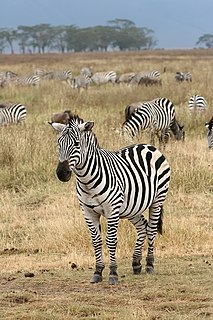 W
WZebras are African equines with distinctive black-and-white striped coats. There are three living species: the Grévy's zebra, plains zebra, and the mountain zebra. Zebras share the genus Equus with horses and asses, the three groups being the only living members of the family Equidae. Zebra stripes come in different patterns, unique to each individual. Several theories have been proposed for the function of these stripes, with most evidence supporting them as a deterrent for biting flies. Zebras inhabit eastern and southern Africa and can be found in a variety of habitats such as savannahs, grasslands, woodlands, shrublands, and mountainous areas.
 W
WThe horse is a domesticated one-toed hoofed mammal. It belongs to the taxonomic family Equidae and is one of two extant subspecies of Equus ferus. The horse evolved over the past 45 to 55 million years from Eohippus, a small multi-toed creature, into the large, single-toed animal of today. Humans began domesticating horses around 4000 BC, and their domestication is believed to have been widespread by 3000 BC. Specifically, horses in the subspecies caballus are domesticated, although some domesticated populations live in the wild as feral horses. However, these feral populations are not true wild horses, as this term is used to describe horses that have never been domesticated. There is an extensive, specialized vocabulary used to describe equine-related concepts, covering everything from anatomy to life stages, size, colors, markings, breeds, locomotion, and behavior.
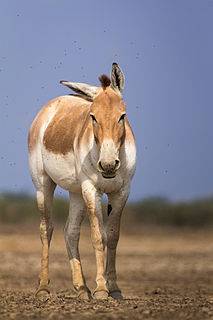 W
WThe Indian wild ass, also called the Indian onager or, in the local Gujarati language, Ghudkhur and Khur, is a subspecies of the onager native to Southern Asia.
 W
WThe kiang is the largest of the Asinus subgenus. It is native to the Tibetan Plateau, where it inhabits montane and alpine grasslands. Its current range is restricted to the plains of the Tibetan plateau; Ladakh; and northern Nepal. Other common names for this species include Tibetan wild ass, khyang and gorkhar. Travellers' accounts of the kiang are one inspiration for the unicorn.
 W
WThe maneless zebra is a subspecies of the plains zebra spread over the northern parts of eastern Africa. It ranges in northwestern Kenya to the Karamoja district of Uganda. It is also found in eastern South Sudan, east of the White Nile. It is the northernmost subspecies of the plains zebra. The last remaining substantial population is in Kidepo Valley National Park.
 W
WThe Mongolian wild ass, also known as Mongolian khulan, is the nominate subspecies of the onager. It is found in southern Mongolia and northern China. It was previously found in eastern Kazakhstan and southern Siberia before being extirpated there through hunting. As of 2015, the Mongolian wild ass is listed as Near Threatened by the IUCN. Current population estimates are approximately 42,000 individuals in Mongolia and around 5,000 individuals in Northern China.
 W
WThe Nubian wild ass is the nominate subspecies of African wild ass, and one of the ancestors of the domestic donkey, which was domesticated about 6,000 years ago. It is presumed to be extinct, though two populations potentially survive on the Caribbean island of Bonaire and in Gebel Elba.
 W
WThe onager, also known as hemione or Asiatic wild ass, is a species of the family Equidae native to Asia. A member of the subgenus Asinus, the onager was described and given its binomial name by German zoologist Peter Simon Pallas in 1775. Five subspecies have been recognized, one of which is extinct.
 W
WThe Persian onager, also called the Persian wild ass or Persian zebra, is a subspecies of onager native to Iran. It is listed as Endangered, with no more than 600 individuals left in the wild and only 30 individuals living within North American institutions.
 W
WThe Somali wild ass is a subspecies of the African wild ass.
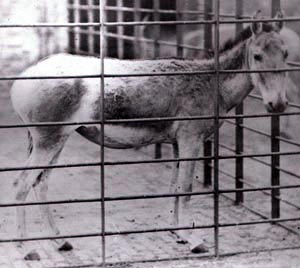 W
WThe Syrian wild ass, less commonly known as a hemippe, an achdari, or a Mesopotamian or Syrian onager, is an extinct subspecies of onager native to the Arabian peninsula and surrounding areas. It ranged across present-day Iraq, Palestine, Israel, Iran, Jordan, Saudi Arabia, Syria, and Turkey.
 W
WThe term tarpan refers to free-ranging horses of the Russian steppe from the 18th to the 20th century. It is generally unknown whether those horses represented genuine wild horses, feral domestic horses or hybrids .The last individual believed to be a tarpan died in captivity in the Russian Empire during 1909.
 W
WThe Turkmenian kulan, also called Transcaspian wild ass, Turkmenistani onager or simply the kulan, is a subspecies of onager native to Central Asia. It was declared Endangered in 2016.
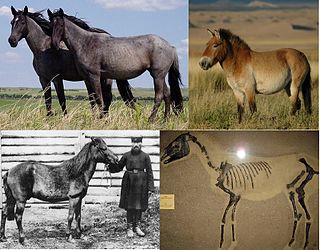 W
WThe wild horse is a species of the genus Equus, which includes as subspecies the modern domesticated horse as well as the undomesticated European wild horse, and the endangered Przewalski's horse. The European horse known as the tarpan that went extinct in the late 1800s has previously been classified as a subspecies of wild horse, but more recent studied have cast doubt on whether those horses were truly wild, or if they actually were feral horses or hybrids.
 W
WZebras are African equines with distinctive black-and-white striped coats. There are three living species: the Grévy's zebra, plains zebra, and the mountain zebra. Zebras share the genus Equus with horses and asses, the three groups being the only living members of the family Equidae. Zebra stripes come in different patterns, unique to each individual. Several theories have been proposed for the function of these stripes, with most evidence supporting them as a deterrent for biting flies. Zebras inhabit eastern and southern Africa and can be found in a variety of habitats such as savannahs, grasslands, woodlands, shrublands, and mountainous areas.